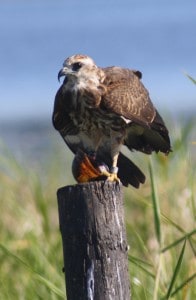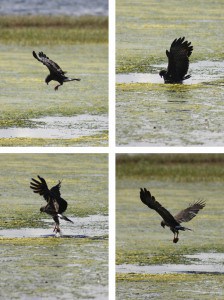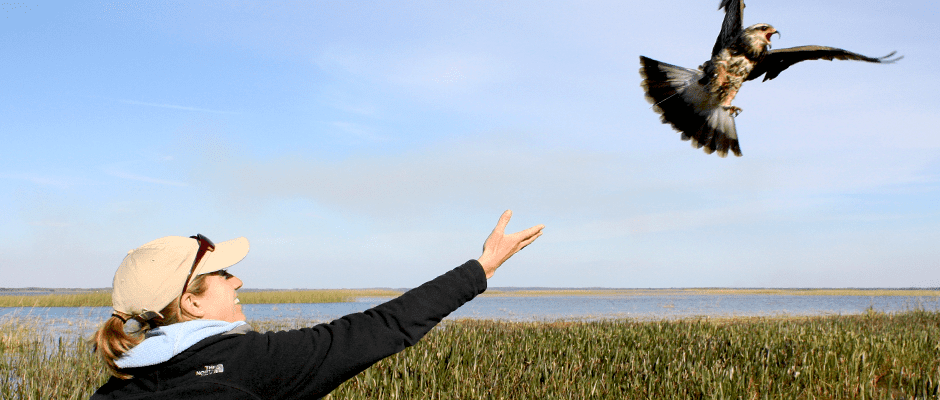Share this article
Invasive snails rescue endangered bird of prey
Endangered kites in Florida may have an unlikely savior: a type of invasive snail the size of a baseball. Until recently, the Florida population of snail kites (Rostrhamus sociabilis plumbeus) fed almost entirely on Florida apple snails (Pomacea maculata), which can only live under specific wetland conditions. But an invasive snail from South America can survive in a much wider range of habitats, including human-made wetlands such as retention ponds and impounded cattle pastures. And where the new snail spreads, the kites are following.
“You have an expansion of foraging to wetlands that were never used before,” said Kyle Pias, a conservation biologist with the Hono O Na Pali Seabird Mitigation Project in Hawaii and first author of a study recently published in the Journal of Fish and Wildlife Management. “You’ve taken a bird that used to be traditionally very heavily tied to pristine Everglades marshes, and now you’ve suddenly allowed it to be a bird that can forage off of power lines on the side of highways.”

A juvenile snail kite feasts on an invasive island apple snail. ©Kyle Pias
Florida was once home to thousands of snail kites, most of which lived around the Everglades. But the kites’ numbers dropped from about 3,400 in 1999 to just 700-800 in 2008 and 2009, possibly due to human activities that prevented natural water level fluctuations, says Pias.
Many of the remaining kites left the Everglades area, moving north to lakes that had formerly served as backup habitats during drought. Their arrival coincided with the spread of invasive island apple snails (Pomacea maculata) through the same lakes, a pattern that may not be coincidence. According to a recent study in Ecological Applications, kites are more likely to breed in areas with the invasive snails, and juvenile kites are more likely to survive.
“The kites are matching the spatial spread of the snail as it continues to invade wetlands throughout Florida,” said Pias, who was not involved in the Ecological Applications study.
To find out how the birds were adapting to these changes, Pias and his colleagues trapped kites around Lake Tohopekaliga (also known as Lake Toho) and fitted them with radio tracking devices. They then monitored 27 kites in 2010 and 25 in 2011, following the birds in boats and recording every detail of their behavior. “We lived the life of a snail kite for those years,” Pias recalled.
In addition to their traditional lake habitat, the kites used five nearby wetlands that were heavily altered by humans. These off-lake wetlands were devoid of native Florida apple snails, but they teemed with invasive island apple snails. Twenty-three percent of kites in the study foraged both on and off Lake Toho, while another 23 percent foraged exclusively in the novel, off-lake sites.
On the whole, the island apple snail invasion seems to be a boon for the kites. Snail kite populations in Florida have been growing in recent years, with the latest estimate topping 1,700 individuals, according to a 2015 report prepared for the Army Corps of Engineers. But the trend is not without risks.

A snail kite captures a snail on Lake Tohopekaliga. ©Kyle Pias
For example, small, human-altered wetlands may make hazardous nesting habitats, since humans often drain such areas to suit their own needs. Snail kites nest on plants such as willows and cypress that rise from the water’s surface, and if the water disappears, the nests almost always succumb to predation. The researchers watched this happened at Shingle Marsh, the only off-lake site with suitable vegetation for nesting. In 2010, the landowner began pumping water out of Shingle Marsh in order to graze cattle, exposing two of the site’s 17 nests. Both exposed nests were destroyed by raccoons.
The landowner stopped draining his cattle pasture when he learned what was going on. Still, says Pias, the incident highlights how easily humans could harm kites in new habitats.
“Because we were there and watching it, we were able to intervene on that instance,” he said. “It becomes difficult to monitor to that level of scrutiny on a wetland-by-wetland basis.”
People shouldn’t expect new habitats to replace the old ones, Pias says. Most kites in the study still foraged and nested on Lake Toho, and a successful future for the kites will likely involve both new and traditional habitats. But, he says, the kites’ use of altered landscapes is a promising sign. It demonstrates that even species with narrow niches can sometimes adapt to a changing world.
Header Image: A researcher releases a snail kite after attaching a radio transmitter to its body. ©Kyle Pias








